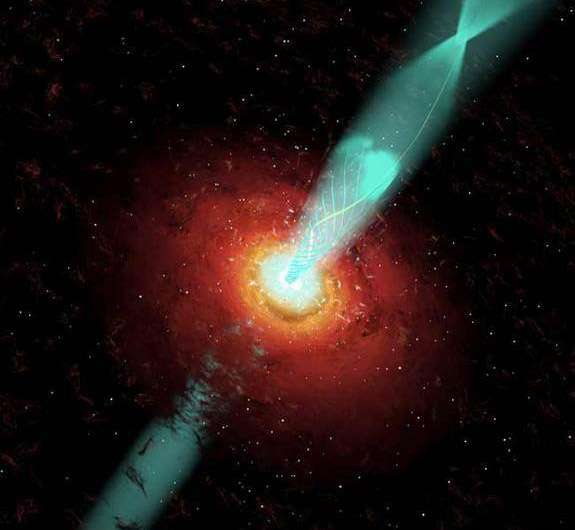A blazing gamma-ray source

Blazars are galaxies whose central, supermassive black holes are accreting material from surrounding regions. Although black hole accretion happens in many galaxies and situations, in the case of a blazar the infalling material erupts into a powerful, narrow beam of high velocity charged particles that, fortuitously, is pointed in our direction. The charged particles produce gamma ray photons, each photon packing over a hundred million times the energy of the highest energy X-ray photon seen by the Chandra X-ray Observatory. The electron beam produces many other effects, and in blazars these include rapid, strong, and incessant variability. They sometimes also include the ability to generate high-energy gamma rays.
The blazar 1ES1741+196 was first spotted in 1996 by the Einstein X-ray satellite. Followup observations determined that it is a triplet system: an elliptical galaxy with two companion galaxies close enough nearby to be an interacting triplet; a tidal tail is observed, for example, presumably the result of mutual gravitation influences. The interactions might play a role in stirring up material for black hole accretion. In 2011, astronomers discovered that the object also emitted gamma rays, but at an intensity that made it one of the faintest such sources known.
VERITAS, the Very Energetic Radiation Imaging Telescope Array System, is an observatory designed to study gamma rays. It consists of four 12-m telescopes located at the Fred L. Whipple Observatory at Mt. Hopkins, Arizona. CfA astronomers Wystan Benbow, M. Cerruti, Pascal Fortin, V. Pelassa, and Thomas Roche were members of a team of eighty-eight astronomers who used VERITAS to study 1ES1741+196 in an effort to model this weak gamma ray blazar. They observed it successfully in several energy ranges for thirty hours over a period of several years and were able to obtain, and model, the first very high energy spectrum for the source. In general, high energy photons are produced in two processes: direct radiation from the charged particles, and scattering by the fast-moving particles of lower energy photons to much higher energies. The team successfully modeled this source including only these two, energetic processes. The result suggests that the scientists have accurately characterized this blazar - despite its faintness - as being among those that produce the most energetic gamma rays. They also found, curiously, that there is no evidence for any significant flaring in this source.
More information: "VERITAS and Multiwavelength Observations of the BL Lacertae Object 1ES 1741+196, A. U. Abeysekara et al. MNRAS 459, 2550, 2016. mnras.oxfordjournals.org/conte … /459/3/2550.abstract , DOI: 10.1093/mnras/stw664
Journal information: Monthly Notices of the Royal Astronomical Society
Provided by Harvard-Smithsonian Center for Astrophysics





















